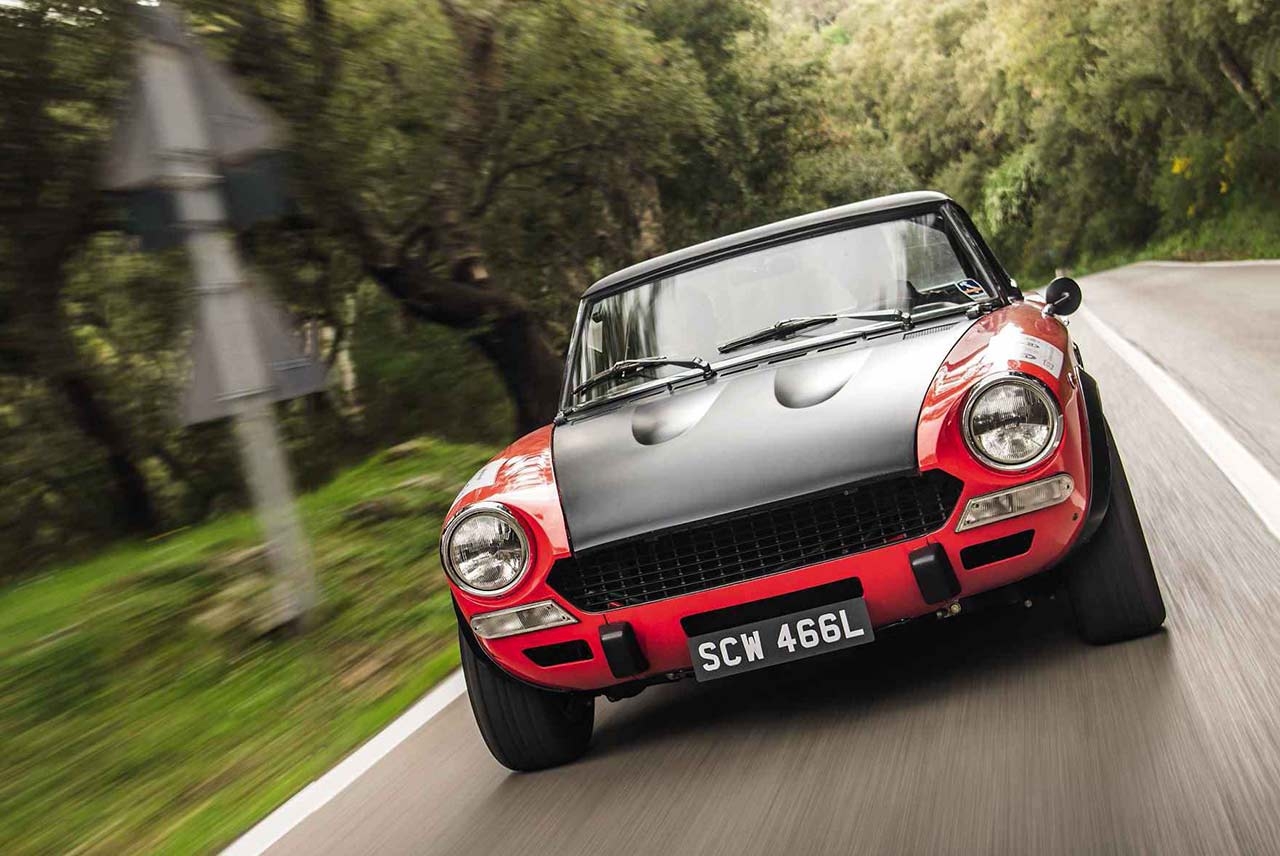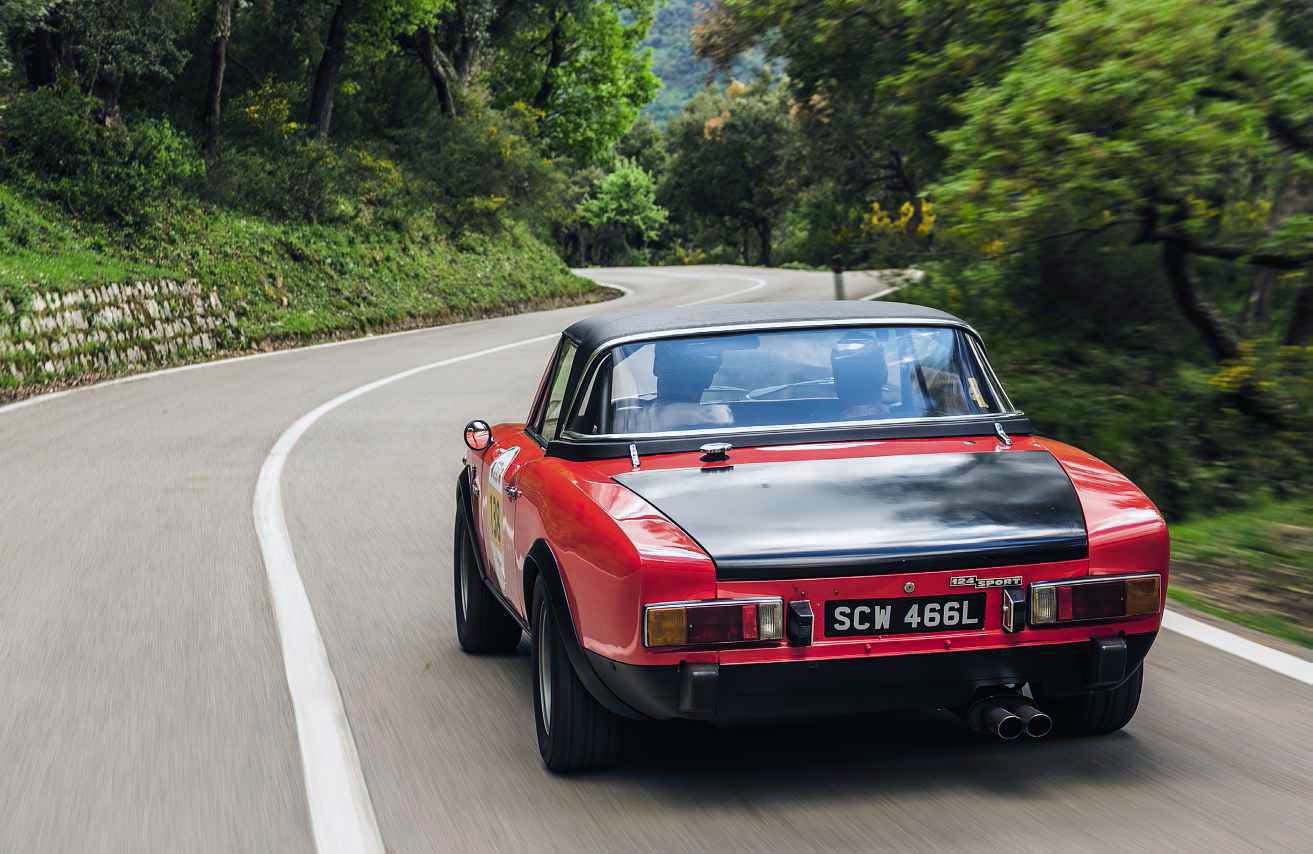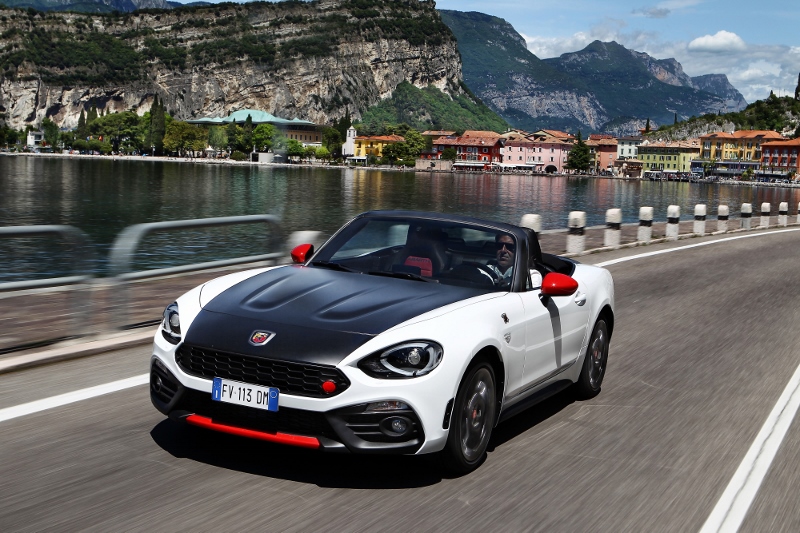
Abarth Adventure. Fiat’s 124 Spider was turned into an unlikely rally star by Abarth. Where better to test one than Sicily, on the Targa Florio Classic? Words Mark Dixon. Photography Olgun Kordal.
ABARTH 124 SPIDER On the Targa Florio in a genuine Abarth.

We’re on a country road a couple of clicks outside a small village in Sicily, and our photographer Olgun has decided that one particular bend, shaded by trees, would be a good place to set up for a few pics. So we park the Abarth 124 Spider under the trees, and Olgun starts to fuss with his photo gear. There’s a chill wind blowing on this April morning, and maybe it’s the cold that impels me to answer a call of nature. Being British, I scramble down to a culvert beneath the road, where I’ll be less visible to passing traffic.
Nature answered, I spot something old and rusty at the far end of the culvert. It looks like an old fuel tank with an X-shaped pressing. Maybe it’s car related? I get closer and realise it’s actually an American jerrycan from the Second World War, boldly stamped ‘USA’. It must date from the liberation of Sicily in 1943, when some 7500 Allied servicemen died in a fierce operation to retake the island from the occupying German and Italian forces. I wonder what sights this rusty relic might have seen, 74 years ago, bouncing along on the back of a Jeep. But that’s Sicily: wherever you go, you can’t avoid its history.
A significant part of Sicily’s history, in the years when people weren’t fighting over it, is the Targa Florio. First run in 1906, this roadrace around the mountainous island was finally axed in 1977, after an accident that killed two spectators. It had already been dropped from the World Sportscar Championship after 1973, due to other fatal crashes; the second-placed finisher in 1972, Helmut Marko, reputedly described it as ‘totally insane’.
Given the event’s prestige and, yes, its notoriety, it was inevitable that it would be revived sooner or later. So, as with the Mille Miglia, there’s now a ‘classic’ Targa Florio, which is run in parallel with a modern rally event. Which is why the owner of the Abarth and I meet for the first time over dinner, the night before the start of the Targa Classic.
American-born but London-domiciled art dealer Kenny Schachter is so besotted with his classic cars that he had his office remodelled so that he could look at them while working. By his own admission, however, Kenny spends more time looking at cars than driving them. In fact, apart from a brief spell with, yes, a 124 Spider at the age of 17, he didn’t even own a car until he was in his 30s.
‘I bought that Fiat for, like, no money and it broke down on the way home,’ he tells me. ‘I don’t even know whether it was rusty or not because I was too green to tell. After that I didn’t have a car for years – living in New York, I didn’t need one.’
The 124 Spider that Kenny now owns is definitely not rusty. It’s not just a regular 124, either, but one of the super-rare Abarth Stradale road cars that were built in 1972 to homologate Fiat’s forthcoming rally cars. Of the 1013 Abarth 124 Spiders that were built, it’s probably the best and most original unrestored survivor there is; so nice that Abarth’s own heritage department offered to buy it from Kenny when they came over to certify it. And here we are, about to thrash it around the mountains.
The Targa Florio Classic is a threeday event, Friday to Sunday, with scrutineering on the Thursday before. This takes place in the courtyard of Palermo’s University engineering and aviation department, which gains kudos for having not only a Lockheed Starfighter F104-S jet mounted outside, but a handsome 1940s Fiat G59 piston-engined fighter displayed inside, as well as a fine collection of historic engines. It’s intriguing to note that the Fiat fighter is powered by a Rolls-Royce Merlin.
There’s plenty of time to study these distractions because scrutineering consists of little more than a cursory check of the chassis plate; not even a glance to see whether seatbelts are fitted. In fact, Kenny has had lap-belts installed specially for the event, but neither of us is convinced that smashing our foreheads into the dashboard is going to improve our chances of survival in the event of an accident. The entry list is, shall we say, not quite so rigorously policed as the Mille Miglia’s, either.
There are some beautiful cars, granted. Leading collector Corrado Lopresto has entered three Alfa Romeo prototypes – the two-tone pastel blue and white 1956 Giulietta Sprint Veloce by Bertone is a stunner; Swiss cardiac surgeon and Zagato enthusiast Axel Marx has brought along a gorgeous Alfa 6C 1750 Zagato. The supporting cast includes Alfa GTa and Junior Zagato, a handful of Lancia Fulvia HFs, plus some more esoteric machinery such as a 1939 Fiat-Zanussi. Less convincing are the Jensen Interceptor Convertible and what looks suspiciously like a fake Jaguar D-type.
Besides Kenny’s 124 Abarth, there is a fullhouse rally version belonging to a Brit called Mick Wood, plus a couple of others from the Continent. Although the 124 Abarth made its debut late in the Targa Florio’s life – Fiat seemed more preoccupied with entering it for ‘proper’ stage rallies on the loose stuff, rather than tarmac events – it dominated its class (Grand Touring cars, 1601-2000cc) in 1974, by taking first, third, fourth and fifth.
There’s a ceremonial start late on the Thursday afternoon, of the kind so beloved by Italians – all inflatable arches and excitable commentators – but the Targa proper doesn’t get underway until Friday morning. The first stage will begin in Taormina, at the northeastern tip of the island, which means a lengthy transit stage at the close of Thursday. It will be a good shakedown run for the Abarth, which has done few miles in recent years but has at least benefited from a thorough fettling by Kenny’s favourite engineer, Stuart Gurr.
Kenny gets first dibs behind the wheel, natch, and we settle in for the long autostrada haul into the mountains. There’s plenty of time to shoot the breeze and take stock. It’s pretty civilised in here, with cord-trimmed Recaro bucket seats, a leather-rimmed wheel for the driver and, rather surprisingly, a wooden dashboard, reminiscent of 1970s Triumphs in its unconvincing appearance.
‘All the experts say it isn’t correct,’ yells Kenny over the blare of the engine. ‘Abarths were supposedly always supplied with alloy dashes. But this was a one-owner car when I bought it, and the seller was adamant that it had always been like that. I guess that maybe the dealer fitted it at the buyer’s request.’
Behind and above us is a roll-over bar, which is reassuring because the hardtop is made of black glassfibre, along with the bonnet and wheelarch lips. The Abarth version of the Spider, dubbed the 124 CSA Stradale, was pretty extensively modified, in fact. Leaving aside the cosmetic weight-saving changes – no bumpers; doorskins and valances in aluminium – there are a lot of differences to the suspension underneath. Different uprights, extra tie-rods and a Rose-jointed anti-roll bar up front; a completely redesigned rear end that utilises reversed lower wishbones, trailing arms and coil springs, with diff’ mounted to the chassis, rather than the regular 124’s beam axle. Oh, and the diff’ is limited-slip, too.
The 1756cc engine, borrowed from the 132 saloon, is not particularly trick: a hot cam, four-branch exhaust manifold and twin Weber 44 IDFs are the main mods. But it’s a tough little thing. Kenny is not sparing the horses and it’s pulling 5500rpm for long stretches of autostrada. After a while, the oil pressure needle heads south, worryingly so, but the engine seems perfectly happy, we put it down to a duff sender, cross our fingers and press on.
Our confidence is justified when the Abarth snorts into our overnight halt at Giardini Naxos, a town on the eastern coast, about three hours later. But tomorrow is when things will get more challenging.
After another official start under yet another inflatable arch, we head up along the coast, the blue Ionian sea sparkling to our right. There are a couple of diversions inland to satisfy the organisers’ need to insert some regularity tests – which we have already decided to ignore, since there’s no way we stand a cat in hell’s chance of troubling the leader board – before it’s back down the coast, and then striking into the mountains of the interior.
Within just a few kilometres, once we’ve left the (relatively) more densely populated coast, the 21st Century starts reeling backwards: glance away from the remarkably well-surfaced tarmac and there’s little to say whether you’re in the modern era, the medieval or, indeed, the Roman. Roadsigns point to villages with multi-vowelled names that roll languidly off the tongue – Caltavuturo, Roccapalumba, Castellana Sicula – while the green-flocked, rocky landscape stretches in all directions beneath a vast, brooding sky.
And now it’s my turn to drive. We pull over, swap places and I drop into that comfortable Recaro. The engine re-starts instantly – it is a little gem – and I point the car’s nose back onto the road; the steering feels disconcertingly light, and I worry that it’s not going to provide any feedback once we really start to hustle.
Tentative push on the brake pedal. Hmm, there’s a long travel before they respond (mechanic Stuart suspects a scored master cylinder) but they do work and they pull the car up evenly. Once it’s evident that the brakes aren’t going to let us down, confidence grows and I start to lean harder on the car. And it comes alive.
The steering, so worrisomely light at sightseeing speeds, loads up perfectly as we thread through a series of tight twisties, but it’s never tiring. The 124 Spider was notably rigid for a convertible of this era and we start to realise why it made such a good rally weapon: it feels beautifully balanced and benign, flowing smoothly between corners, and any rear-end breakaways are easily caught with the smallrimmed wheel. The only debit is excessively soft rear suspension that causes the rear tyres to graunch alarmingly against the glassfibre spats on sudden compression, fortunately without causing any apparent damage.
The engine’s flexibility impresses, too. Although it thrives on revs, it pulls cleanly and in linear fashion from 2000rpm in the upper gears, never fluffing or hesitating, and the urge doesn’t let off towards the 6200rpm redline. It’s not an exotic-sounding motor, rather a purposeful one, with a crisp, uncomplicated kind of four-cylinder blare that’s suggestive of fine engineering but nothing unduly fancy. Just what you need in a rally car, in short.
Today and the following Saturday pass in a kaleidoscopic blur of intricate mountain roads, hilltop villages, coastal checkpoint rendezvous with other competitors, and end-of-day cruises back along the autostrada to Palermo. Although it covers a lot of ground, the Targa Florio Classic has proved a much less pressured event than the Mille Miglia: it’s just as well-organised but rather more laidback. Add in the appreciable advantages of days that finish at a reasonable hour, and sparse traffic on challenging roads that are the equal of any in Europe, and its appeal is easy to understand.
Complete strangers when we started, Kenny and I have bonded during our hours of enforced proximity, and it’s gratifying to watch how Kenny, who rarely gets much time to drive his cars back home, is getting into the rhythm with his Abarth – when he’s not negotiating some million-dollar art deal on his phone, that is, or telling me how he got locked out of his Palermo hotel room, on the balcony, wearing only his boxers. (No confidences betrayed here: read his blog on the Artnet website by googling ‘Kenny Schachter goes for a drive’.)
We knew from the start that we’d have to duck out of the Targa early, due to limited options on flights home; so when it’s decided that Kenny’s car is needed for extra photographic duties on the Sunday, I make my excuses and go exploring Palermo on foot.
Parc fermé at the university is only a couple of miles from the harbour, and walking through the city’s backstreets gives a far better idea of the place’s character than when it’s seen from a moving car. The parts further out of town are little more than slums, home to the immigrant population that’s crossed the Med from North Africa, and it’s only the ever-present sunshine that makes these crumbling buildings, with lines of washing strung across narrow alleys, seem romantic rather than depressing. There are occasional patches of waste ground that look very much like undeveloped bomb sites from World War Two, and probably are.
Closer to the sea-front, the markets are in full swing, including Palermo’s famous fish market, where you can buy squid, sardines and tuna as big as a man’s torso. The noise and bustle is in powerful contrast to the eerily deserted villages we passed through on the Targa yesterday.
There’s also a huge bric-a-brac market, disappointingly light on old car stuff other than the inevitable bits of Fiat 500. Yet even here, among the battered light fittings, faded prints and broken toys, there are reminders of Sicily’s turbulent history: old ashtrays decorated with Mussolini’s portrait on one stall, a pre-war pamphlet of his speeches on another.
The past is all around you on this island that is, literally, a stepping stone between continents, and endlessly fascinating as a result. As for that WW2 jerrycan I discovered – well, I didn’t bring it home, but I know exactly where it is. Next year’s Targa, anyone?
Tech and photo
TECHNICAL DATA FILE SPECIFICATIONS 1972 Abarth 124 Spider
Engine 1755cc four-cylinder, DOHC, two Weber 44 IDF 20 carburettors
Power 128bhp @ 6200rpm DIN
Torque 117lb ft @ 5200rpm DIN
Transmission Five-speed manual, rear-wheel drive
Steering Worm and roller
Suspension Front: double wishbones, coil springs, telescopic dampers, angled tie-rods, anti-roll bar. Rear: lower wishbones, trailing arms, coil springs, telescopic dampers, anti-roll bar
Brakes Discs
Weight 850kg (approx)
Performance
Top speed 118mph
0-60mph c7.5sec
{module Fiat 124}
‘KENNY IS NOT SPARING THE HORSES, AND THE ABARTH IS PULLING 5500RPM FOR LONG STRETCHES OF AUTOSTRADA’
Clockwise from left Targa’s Sicilian landscape is mountainous and rugged; 132 saloon-sourced engine suitably tough too; Targa Florio route takes in picturesque coastline; wherever you go, locals are happy to reminisce. Left and above right Wooden dashboard is an anomaly for an Abarth 124 Spider, but believed original to this car; bootlid, hardtop and bonnet are all made of thin glassfibre to save weight. Below, from left Starfighter jet towers over cavalcade of Ferraris; Scuderia del Portello looking most professional; Kenny Schachter at the wheel; Abarth, Alfa GTV and Lancia Fulvia make picture-perfect array.
IT’S NOT JUST BLACK AND WHITE
Abarth’s latest 124 Spider is a conundrum – but in a good way, says Mark Dixon, after living with it for a week…
No cup holders. And not even a cubby box where you can bodge one up out of a takeaway cardboard tray. It’s a major drawback. If you’re now choking on your Costa coffee – lucky you – at such a trivial complaint, then bear with me. The reason this omission takes on a significance out of all proportion is because the 124 Spider is otherwise a really good everyday car. If you don’t have kids, you could happily manage with this alone.

It doesn’t seem that way when you first fire it up. The exhaust note is on the loud side, enough to cause an inward wince if you are making a 5am start and happen to like your neighbours. It’s a great sound, mind, a kind of deep, rorty burble, with a liquid quality that smooths off any rough edges when you power away.
The big surprise is that this noise is being produced by an engine of only 1.4 litres, albeit turbocharged to develop 170bhp and 184lb ft of torque. It’s enough to make the Abarth feel genuinely quick straight out of the box; press the Sport button and it feels noticeably livelier, an illusion wrought by sharpened throttle response and by looser EST control. It’s quite throttle-steerable, in fact, giving credence to Abarth’s claim that this car has some genuine sting in its tail, and dispelling any fears that it’s merely a Mazda MX-5 (like the regular Fiat 124 Spider, it shares the MX-5’s underpinnings) with an extrovert bodykit.
The seats are supportive, the ride decent, and the hood a masterpiece of simplicity to raise or stow. The Abarth detailing mightn’t be entirely to your taste – the red mirrors on our test car just looked weird, as though they were replacements from a breaker’s yard – but at least they help the car stand out in a crowd. Not that you are likely to see many Abarths: starting at £29,565, it’s a good six grand more expensive than a top-spec MX-5. The price of exclusivity… but for something you don’t have to keep as a weekend toy.






